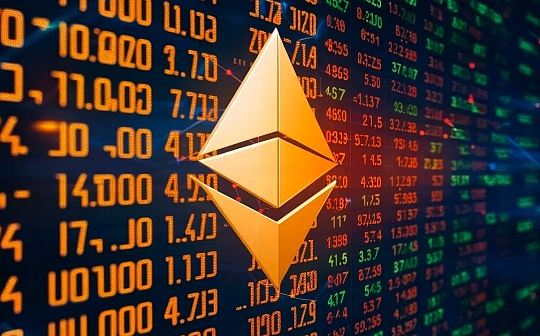
Deng Tong, Bitchain Vision
From being dissatisfied many times to breaking through $4,300, from April to now, in just a few months, Ethereum has gone from amidst doubts to the center of the highly anticipated crypto-stage.What factors have driven the big rise in Ethereum?How high will ETH rise?What are the leading DeFi tokens worth paying attention to?
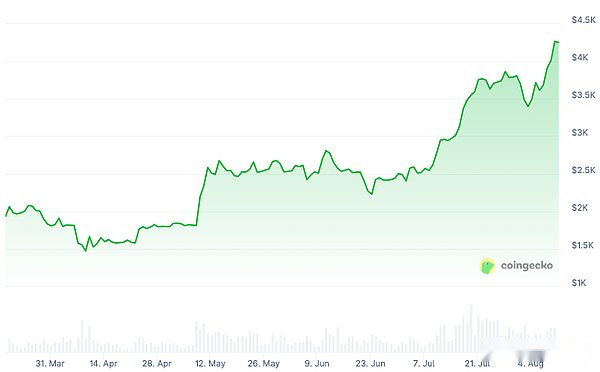
1. What factors have driven the sharp rise in ETH?
April: Regulatory benefits
In April 2025, ETH ushered in an upward trend.From the annual low of $1385 on April 6 to $1750 on April 23, an increase of 26.3%, with a maximum daily increase of even more than 10%.
The driving factors of this round of upward trend can be attributed to the promotion of positive regulatory measures.
On February 4, 2025, the draft GENIUS Act was proposed.On March 13, the Senate Banking Committee passed the GENIUS bill with a bipartisan support rate of 18 votes in favor and 6 votes against, formally submitting the bill to the Senate.On May 8, the Senate ended the first vote on a debate motion.Before this,The GENIUS Act’s expectations of rising to the crypto market have been fermenting.ETH ushered in a rush before the GENIUS Act was finally approved.
On April 10, the first cryptocurrency bill in the United States came into effect.Trump signs bill to repeal the IRS controversial tax reporting rules for DeFi platforms, the rule originally planned to require the DeFi protocol to send 1099 tax forms to users.The bill passed in the Senate by 70 to 28 and the House of Representatives by 292 to 132, the first U.S. bill specifically targeting cryptocurrencies.The bill came into effect boosted industry confidence, with DeFi locked positions (TVL) growing 4.2% in a week to $46.7 billion.
On April 24, the Federal Reserve announced the complete withdrawal of 2022 regulatory guidelines on bank crypto assets and US dollar token business, abolish the 2023 “regulatory no objection” procedure and withdraw from the cryptoasset risk policy statement jointly issued with the Federal Deposit Insurance Company (FDIC) and the Office of the Regulatory Commission (OCC).The move marks the end of the US’s high-pressure regulatory policy on the crypto industry, “Suffocation Point Action 2.0”, where banks can re-provid accounts and payment channels for crypto companies. Stablecoin USDC issuer Circle and other institutions have stated that they will accelerate cross-border payments and DeFi applications.
2. May – Today: Pectra upgrade, Ethereum treasury reserve trend
On May 7, Ethereum successfully implemented the Pectra upgrade, which is the most important network update after the 2022 merger (The Merge).This hard fork contains 11 EIP improvement proposals, focusing on three major directions: improving staking efficiency, optimizing user experience, and enhancing Layer2 scalability.The successful deployment of testnet Hoodi in March laid the foundation for this upgrade.Pectra lays the foundation for the Fusaka upgrade, which will introduce key technologies such as Verkle Trees and PeerDAS.The most eye-catching thing in this upgrade is the EIP-7702 account abstraction solution, which allows ordinary wallets to temporarily execute smart contract functions. In the future, users can realize innovative experiences such as third-party payment of Gas fees, batch packaging transactions, and even recover lost private keys through social contacts.In terms of pledge mechanism, the upper limit of ETH pledge of a single verification node has been greatly increased from 32 to 2,048, and institutional pledgeers can reduce the complexity of operation and maintenance through node merging.For Layer2 expansion, the Blob data capacity of each block doubled to 6 (9 peaks).
From May to the present, many companies have successively announced plans for Ethereum treasury.
-
On May 27, SharpLink Gaming announced that it had signed a securities purchase agreement to conduct a public corporate private equity investment (PIPE) of $425 million, with plans to issue approximately 69.1 million shares of common shares (or equivalent securities) at a price of $6.15 per share ($6.72 per share for the company’s management team).SharpLink Gaming uses the funds raised to purchase ETH as the company’s main treasury reserve assets.
-
On May 31, the board of directors of Mega Matrix Inc., a listed company on the New York Stock Exchange, approved Bitcoin and Ethereum as treasury reserve assets;
-
On June 26, Bit Digital, a listed US stock company, announced a strategic transformation, planning to gradually stop the Bitcoin mining business, and gradually convert the BTC it holds into ETH, focusing on Ethereum pledge and asset allocation, becoming a “pure Ethereum pledge and treasury company”;
-
On July 9, GameSquare Holdings, Inc. announced that the board of directors has approved the establishment of an Ethereum treasury in phases, with a total amount of up to $100 million;
-
On July 22, BitMine announced that ARK Invest has acquired 4,773,444 shares of BitMine common stock BMNR with a total value of US$182 million.BitMine plans to use all net income (approximately $177 million) to purchase ETH;
-
On July 26, Sandclock, a decentralized wealth management platform that supports insurance and SOC-2 certification on the access chain, announced the launch of the ETH treasury strategy;
-
On July 30, Nasdaq-listed Fundamental Global Inc. announced the sale of 40 million common shares at $5 per share, with an estimated total revenue of $200 million, which will be used to launch the company’s Ethereum treasury strategy;
-
On August 5, Nasdaq listed company 180 Life Sciences Corp. (ETHZilla) announced that it had completed a private equity financing of US$425 million and officially launched the ETH treasury strategy;
-
On August 10, China Procuratorate Medical issued an announcement stating that it had officially launched the “global enhanced version of Ethereum treasury with downward protection mechanisms”.
In response to the trend of many companies establishing Ethereum treasury reserves, Nick Tomaino, founder of 1confirmation, published a statement saying that 1confirmation fully supports ETH, because without Ethereum, the crypto industry cannot continue to develop, and the innovative values of trustworthy, neutral, open source, and face-to-face license must be spread.Nowadays, the crypto industry focuses on VC chains and corporate crypto treasury. Although this trend is not closely related to Ethereum values, it does not mean that it may be a good thing for companies to establish ETH treasury.As encryption pioneer Hal Finney said 33 years ago: “Computers should be used as tools to liberate and protect humans, not as tools to control humans.”
3.7: Trump signs GENIUS bill, encryption week begins
On July 19, the U.S. House of Representatives passed a stablecoin bill, and US President Trump officially signed the “Guiding and Establishing a U.S. Stablecoin Country Innovation Act” (GENIUS Act) at the White House, marking the implementation stage of the US stablecoin regulatory legislation and the cryptocurrency industry ushered in a turning point.Most stablecoins are issued and traded on Ethereum’s underlying blockchain, pushing up demand for ETH to pay transaction fees as stablecoins pegged to the US dollar increases.The White House published a document praising the passage of the GENIUS Act, which stated that the GENIUS Act is a historic legislation that will pave the way for the United States to lead the global digital currency revolution.President Trump said the bill “creates a clear and concise regulatory framework to establish and unleash the huge potential of a dollar-backed stablecoin. This is perhaps the greatest revolution in the fintech space since the birth of the Internet.”
From July 14 to 18, the U.S. House of Representatives Financial Services Committee opened “crypto week”.Legislators debated and voted on three major crypto bills: the CLARITY Act, which defines regulatory oversight of the crypto market; the GENIUS Act, which sets a framework for stablecoins and has been approved in the Senate; and the Anti-CBDC Monitoring National Act, which would prohibit the creation of U.S. central bank digital currencies.”Cryptocurrency Week” not only brings short-term positive news to the crypto market, but in the long run, the increase in regulatory certainty will attract more institutional funds to enter the market and push mainstream coins such as Bitcoin into the “slow bull” channel.At the same time, sub-tracks such as DeFi and NFT may usher in a new climax due to the exemption clauses of the CLARITY Act.
On July 29, the US SEC officially approved Bitcoin and Ethereum spot ETFs to adopt the “physical subscription and redemption” mechanism, covering products including BlackRock, Ark21, Fidelity, VanEck, Franklin Templeton and other institutions.This adjustment will make fund operations more efficient and cost-effective.The SEC also approved applications for a combination of funds including Bitcoin and Ethereum spot assets, Bitcoin ETF option products, and relaxation of partial option position limits.Chairman Paul Atkins said the move is “part of a more rational regulatory framework” and will benefit the depth and vitality of the US crypto market.
4. August:Project Crypto,SEC Liquidity Pledge Guide
On August 1, US SEC Chairman Paul S. Atkins publicly delivered a speech on the “Project Crypto”: Project Crypto will become the goal of the US SEC, helping President Trump achieve his historic goal and building the United States into the “world’s crypto capital.”He pointed out: First, we will work to bring crypto assets distribution back to the United States; second, to achieve the president’s goal, the SEC has the responsibility to ensure that market participants have the greatest choice when deciding where to custody and trade crypto assets; third, a key task during my tenure as chairman was to allow market participants to innovate with “super applications”; fourth, I have instructed SEC staff to update outdated institutional rules and regulations to unlock the potential of on-chain software systems in our securities market; and finally, innovation and entrepreneurship are the engines of the U.S. economy.
On August 5, SEC staff released a guide on liquidity pledge.Under certain conditions, liquid staking activities and the receipt tokens generated do not constitute a securities issuance.Mara Schmiedt, CEO of blockchain development company Alluvial, noted: “Institutions can now feel at ease to integrate LST into their products, which will surely bring new revenue streams, expand customer base, and create a secondary market for pledged assets. This decision lays the foundation for the wave of new products and services and will accelerate mainstream participation in the digital asset market.” This wave of institutional adoption may help retail traders and influence institutions to provide DeFi services.
2. How high will ETH rise?
As ETH rises better, giant whales are voting with their feet.
-
According to the on-chain analyst Ember Monitor,Since July 10, more than 1.1 million ETH (approximately $4.78 billion) have been hoarded by multiple unknown giant whales/institutions through channels such as trading platforms or institutional business platforms, with the average price of these hoarded ETHs being approximately $3,584.ETH price rose 65% from $2,600 to $4,300 during this period.
-
In the past 24 hours, Arthur Hayes has increased its holdings in ETH and a variety of DeFi blue chip assets, including 1,500 ETH (worth approximately $6.35 million), 425,000 LDO (worth approximately $557,000), 420,000 ETHFI (worth approximately $517,000), and 185,000 PENDLE (worth approximately $1.02 million).
Analysts’ future price forecasts are as follows:
-
Analyst Merlijn said the price increase channel for ETH has been opened.The current maximum target price may be set at $20,000.
-
Trader BitBull noted that ETH prices hit new all-time highs could be easier to achieve due to large-scale short squeezes and institutional buying, if the weekly closing price is above the $4,100 range,New all-time highs may appear within 1-2 weeks.
-
Ethereum is showing signs of breaking through its current Wikov cumulative model, analyst Lord Hawkins said.According to Wikov’s theory, once the buyer gains control, this stage usually ends with a decisive breakthrough.This breakthrough appears to be in progress, with ETH breaking through the $4,200 resistance zone, a phase known as the “Strength Sign” (SOS).In Wikov’s model, this is usually accompanied by a brief callback, or “last support point” (LPS), to confirm a new uptrend.If LPS is established, the price will enter a rising phase, and the upward trend will accelerate as demand exceeds supply.Measure the height of the cumulative range, the technical target price is close to $6,000.
-
As of Sunday, ETH had broken through its multi-year symmetric triangle uptrend line, in the $4,000-4,200 area, Crypto Rover and Titan analysts said.This breakthrough indicates potential price fluctuations, with amplitude equivalent to the highest point of the triangle and pointing toPrices will break the $8,000 area in the coming months.
-
Analyst Nilesh Verma highlighted the repetitive mode, where ETH rebounded sharply after retesting the main bottom support.ETH replayed the same “bottom retest” trend in April 2025, rebounding strongly from the $1,750 to $1,850 range.The ongoing rebound may continue until April 2026 with a solid trend target for the fractal to be “lowest $10,000” and in the best case scenario, $20,000.
3. DeFi leading tokens worth paying attention to
DeFiance Capital founder and CIO @Arthur_0x posted on social media thatThe rise in Ethereum is like a rising tide, which will drive many projects in the decentralized finance (DeFi) space, while the rise in Bitcoin is more isolated.It is expected that in the near future, the top DeFi projects will usher in a series of major progress.
Here are the DeFi tokens worth paying attention to.
1.Lido Finance (LDO)
As Ethereum’s largest liquid staking agreement, Lido accounts for 25% of the pledge market share, an increase of 58.3% on the 7th, and is now at US$1.48.
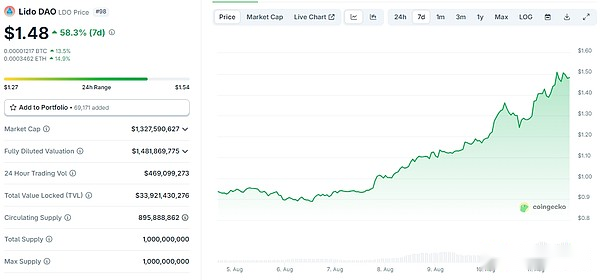
Recent good news:
The EU MiCA Act entered the second phase of implementation in July 2025. Lido, as the first batch of liquidity staking agreements certified by MiCA, has obtained the qualification of a “systemic important stablecoin service provider”; in July 2025, it passed a proposal to invest 20,000 ETH in the vault into Pendle’s fixed income vault, locking in an annualized 6.2% income, which not only optimizes the efficiency of capital use, but also sends a signal of long-term value holding to the market; on August 1, 2025, the Monetary Authority of Singapore (MAS) approved Lido’s payment license, allowing it to conduct cross-border settlement through stETH, which means that stETH can enter the traditional financial system as a compliant asset.
2.Ether.fi (ETHFI)
Ether.fi is the first native liquid staking agreement on EigenLayer, allowing users to pledge ETH or other LSTs (such as stETH) to obtain eETH and earn additional income from restaking on EigenLayer.It is now at $1.26, up 6.5% in 24 hours.
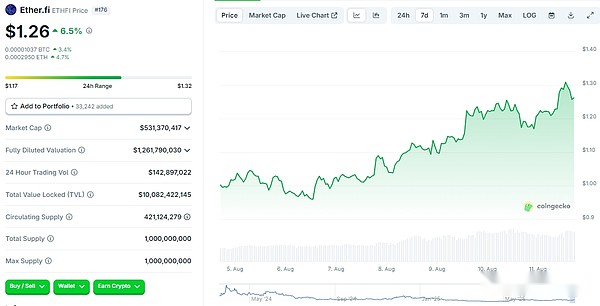
Recent good news:
Ether.fi’s total lockout was US$4.9 billion at the beginning of 2025, and exceeded US$6.2 billion in August, a year-on-year increase of 126%.
In July, the ether.fi community voted to pass the proposal “Deploy ETHFI staking contracts” with a 99.5% approval rate.The proposal seeks approval for the deployment of ETHFI staking contracts on the Ethereum main network, which aims to provide real utility by linking rewards to governance participation and effective balance in the ecosystem, and pledged contracts will include future incentives and voting capabilities for staking tokens.
3.Pendle (PENDLE)
Pendle is an income trading agreement focusing on interest-generating assets. It aims to provide users with interest rate trading tools by separating principal and interest of interest-generating assets to achieve risk management and return optimization.It is now at $5.34, up 1.9% in 24 hours.
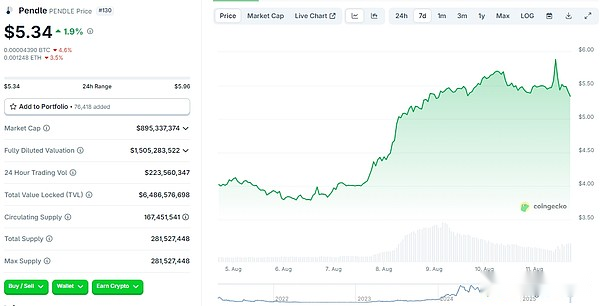
Recent good news:
On August 6, the Pendle team launched Boros, a financing rate trading platform on Arbitrum, through which users can speculate and hedge financing rates. It now supports trading of Binance BTCUSDT and ETHUSDT financing rates, and plans to expand to more assets (such as SOLUSDT, BNBUSDT), more platforms (such as Hyperliquid, Bybit), more maturities and more future earning products.Boros uses income units (YUs) to trade, each YU represents the income of 1 unit of collateral assets until maturity, similar to Pendle’s YT.
Pendle TVL exceeded $8 billion in August, of which Ethereum chain contributed $7.41 billion, and DeFi Llama data shows that it accounts for 58% of the revenue track, five times the second place.
4. Uniswap (UNI)
Uniswap uses an automatic market maker (AMM) mechanism to realize asset exchange.Uniswap automatically matches transactions through liquidity pools, rather than relying on order books and centralized matchmaking.It is now at $11.04, up 3.3% in 24 hours.
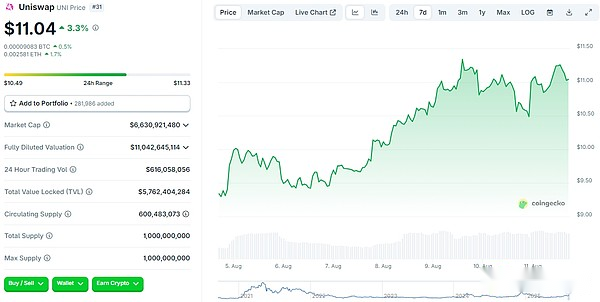
Recent good news:
According to Dune data, the number of transactions in the Uniswap Agreement has reached 7,19,951,542 since 2025, setting a record high in the annual transaction number.
On June 13, Uniswap Labs announced that Uniswap Wallet users can now enable the smart wallet function, unlock one-click redemption through bundled transactions, supporting smarter redemption and lower costs.New wallets created on Uniswap mobile or browser extensions will default to smart wallets.New features in the future will include Gas sponsorship, paying Gas fees with any token, and more.
5.Convex Finance (CVX)
Convex Finance mainly serves Curve Finance’s liquidity provider and CRV token holders and is the revenue optimizer of the Curve protocol.CVX is now at $4.69, up 3.6% in 24 hours.
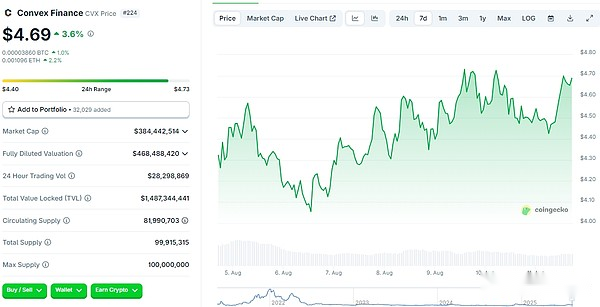
Recent good news:
In June 2025, Convex and Frax Finance reached a strategic cooperation to jointly launch a stablecoin machine gun pool based on CVX, providing users with an annualized return of 8.5%, and the scale of managed assets quickly exceeded US$45 billion.Convex continues to expand its business on Ethereum Layer 2 networks (such as Arbitrum, Optimism), and its cross-chain liquidity pool’s TVL grew by 39% in the second quarter of 2025.
6.AAVE
AAVE is a decentralized, non-custodial liquidity market agreement that allows users to borrow and lend crypto assets without the need for intermediaries.It is now at US$305.29, an increase of 0.4% in 24 hours.
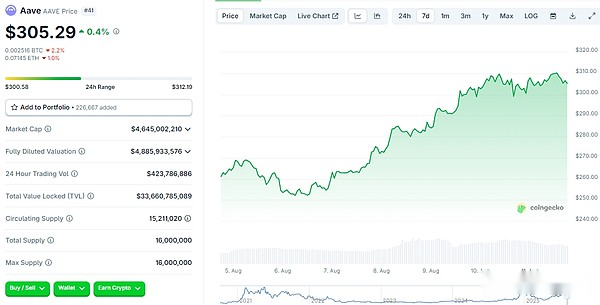
Recent good news:
On August 8, Aave and Plasma jointly launched an institutional incentive fund, which aims to jointly incentivize fintech companies and institutions to migrate their businesses to blockchain and build a new financial system on Plasma.On August 7, Aave’s total deposit size reached US$60 billion, setting a record high for the agreement.







